by Tara Mitchell
The landscape has long been shaped by economics. Marketing tells us which plants are weeds and which are desirable, which insects are pests to be eradicated and which are worthy of saving. While all insects are declining, those chosen to be saved are those that are most visible and that also bring economic benefit: the pollinators. Now, plants such as milkweed, once defined as a weed, are widely promoted. Yet, nature is complex. If we plant only for pollinators, we potentially reduce diversity, disrupt naturally existing plant communities, and don’t provide for the variety of other insects that have important, though less visible, roles.
In a world that is becoming increasingly urbanized, the goal of restoring pollinators becomes more and more challenging. If we plant for pollinators, will they come? Living in a highly urban area, I decided to find out for myself. What pollinators were finding their way to my garden? And what about all those other bugs? In the process of learning about the pollinators, I discovered the equally complex world of the non-pollinators, and realized the unique role that all insects play in sustaining the larger system.
Politics behind the Pollinator Garden
Pollinator Gardens are a recent concept. Reminiscent of the Victory Gardens promoted by the government during World War I and II, the Pollinator Garden effort is intended to help cover food shortages, only this time, for insects. The goal of the effort is to provide sufficient food (nectar and pollen) to reverse the decline of pollinators, bees in particular, and to provide habitat (milkweed) for monarch butterflies.
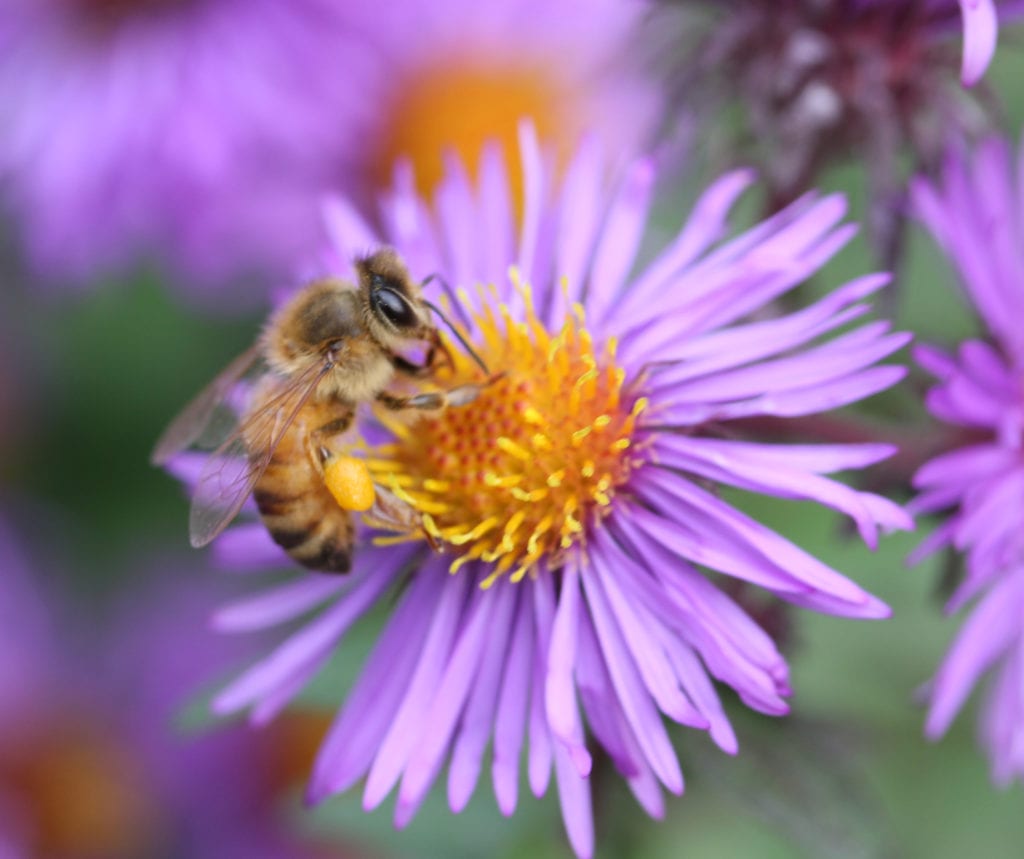
A European honeybee feeds on New England Aster.
Bees, both the European honey bee and native bees, are not only essential for the reproduction of many flowering plants, but are also responsible for pollinating billions of dollars’ worth of agricultural crops. Monarch butterflies, although not economically important pollinators, are also a focus of the Pollinator Garden effort due to their popularity and their highly visible and drastic decline (around 90% over 20 years).
Pollinator decline is attributed primarily to loss of habitat and to the use of pesticides. For bees, the Varroa mite and Colony Collapse Disorder are also causes of decline. Habitat loss is due not only to the conversion of prairie and meadow to cropland but also to the use of herbicides that eradicate wildflowers in the agricultural and ornamental landscape. Roundup Ready® crops (crops genetically engineered to be resistant to Roundup®, a non-selective herbicide produced by Monsanto) are of particular concern: weeds, such as milkweed, that once grew in and adjacent to crops and that provided food and habitat for bees and butterflies are now eradicated by broadcast spraying. Neonicotinoids, systemic insecticides, are applied as seed coatings as well as foliar sprays, resulting in bee exposure due to dust drift during planting and to residue in nectar and pollen. Neonicotinoids are also highly soluble in water and therefore have the potential to spread off-site.
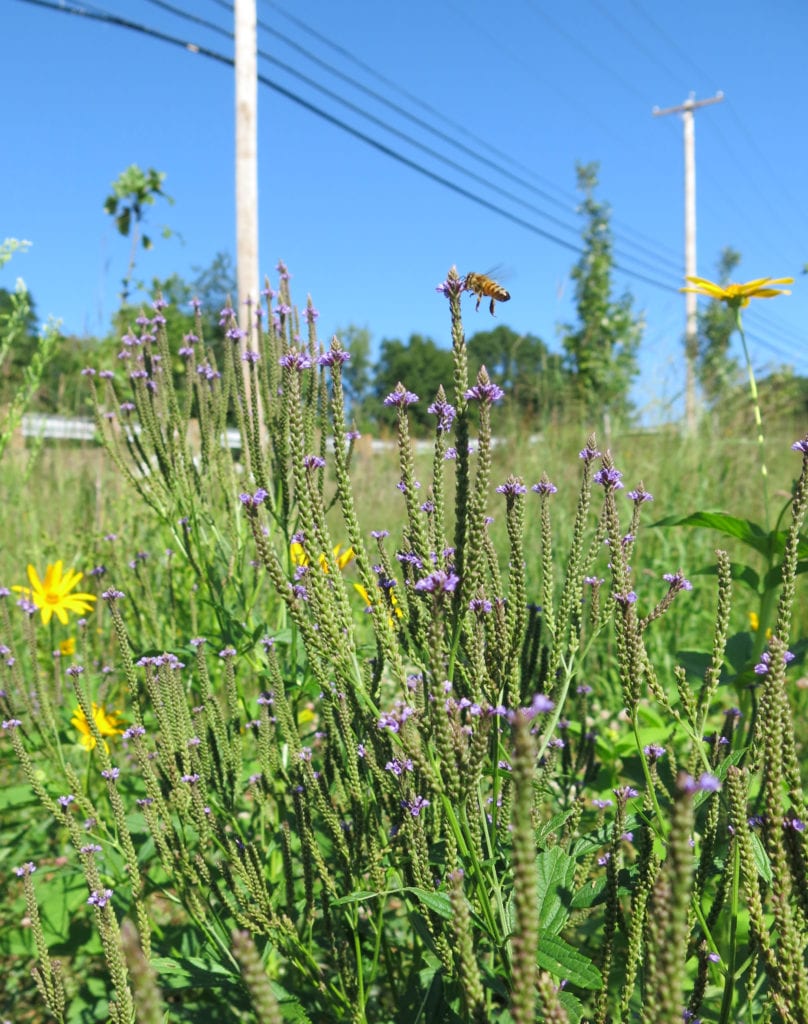
Roadside and utility rights-of-ways are ideal for providing food and habitat for pollinators and other insects.
In response to the alarming decline of pollinators, the US government took action. In 2008, the US Farm Bill made funding available for research on bees and mandated that conservation programs support habitat restoration and management for pollinators. In 2015, the Obama Administration released National Strategy to Promote the Health of Honey Bees and Other Pollinators. Through public-private partnerships, the primary goals of the strategy are to reduce honeybee colony losses, increase populations of the eastern monarch butterfly, and to restore or enhance seven million acres of land for pollinators over the next five years. Educating the public and promoting the idea of pollinator conservation as a national responsibility are also key components: from planting Window Boxes for Pollinators to Monarch Waystations, every citizen can contribute. Specific to insecticides, the Strategy’s focus is on reducing the risk of bee exposure (rather than restricting use of insecticides) and continuing to assess effects on bees.
Public-private partnerships are central to the Strategy. However, with agrochemical companies providing millions of dollars in funding as partners to government, universities, and nonprofit organizations, there are concerns about industry’s influence on the outcomes of research and on regulations and policy. The goal of increasing and sustaining pollinator populations through land restoration means, in real terms, successful establishment and long term management of millions of acres of seeded and planted wildflowers. Even with successful restoration of seven million acres of wildflowers, without protecting existing lands from rapidly expanding agricultural and urban development, there may continue to be overall losses of habitat.
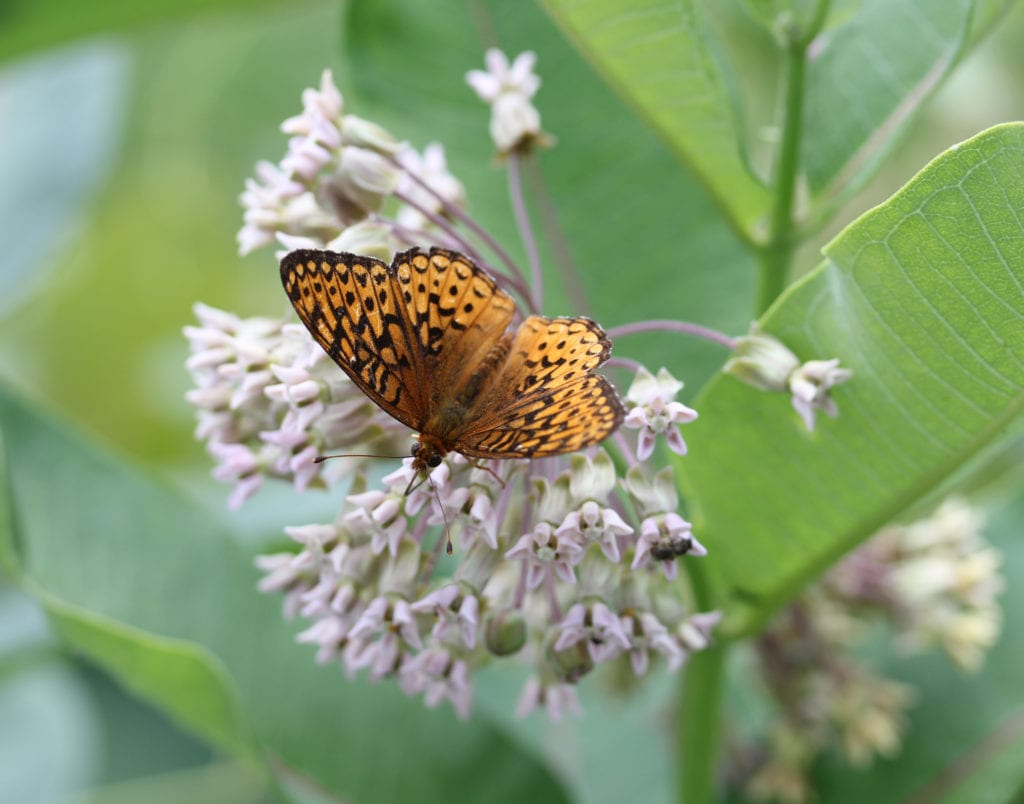
Atlantis fritillary (Speyeria atlantis) feeding on milkweed nectar. Common milkweed is a food source for many insects, as well as a host for monarch larvae.
Ultimately, government and industry are banking heavily on the efforts of farmers, local governments, and citizens to reverse pollinator declines through a nationwide patchwork of wildflower plantings and by adopting pollinator-friendly practices. When there are subsidies and monetary incentives, such as those provided to farmers, there will be participation. In the realm of turf and ornamental landscaping, a multibillion-dollar industry that revolves around a cultural aesthetic of weed and insect free landscapes, achieving those goals will be an enormous challenge. The lawn itself, symbolic of order, prosperity, and patriotism, is the largest managed crop in the US and so deeply embedded in our history and culture that it will likely take generations before Americans allow their manicured carpets of green to descend into the unpredictable chaos of weedy pollinator patches. Milkweed and manicures are simply not compatible.
One Urban Meadow Garden
I began my own garden, not with the goal of creating a Pollinator Garden, but as a meadow garden of grasses and perennials to replace a tiny lawn that served no beneficial purpose. Like a meadow, natural processes and time determine the design. Seeds go where water, wind, or creatures carry them, most often into the crevices between soil and concrete where water collects. New plants of the more prolific self-seeders, such as butterfly milkweed, little bluestem, salvia, and lavender pop up here and there. Sometimes species disappear only to reappear in new locations.
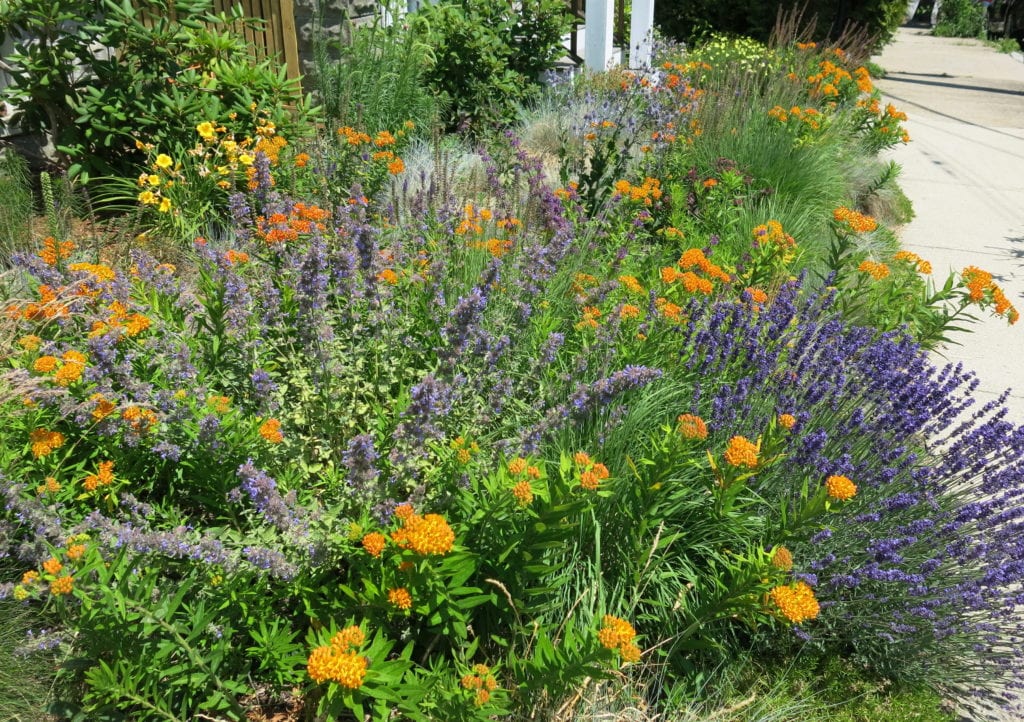
Originally three plants, butterfly milkweed has since spread throughout the garden. Low growing and a prolific self-seeder, it thrives in poor soil to provide stunning color all summer.
Other than the initial planting, my contribution to the design and management is simply to remove undesired plants, particularly those with invasive tendencies such as black swallowwort and Tree of Heaven. Seedlings of desirable plants, I leave in place or transplant to fill in gaps and replace plants that are not thriving. And, like any gardener, I can’t resist periodically adding new species.
Set in an urban landscape, the ecology of the garden is limited by those conditions. It is small, surrounded by concrete, used for snow storage, and subject to salt, trash, cigarette butts, invasive plants, and dog deliveries. I don’t use pesticides, but some of my neighbors use both herbicides and insecticides. For an insect, perhaps my garden is an oasis in a desert of concrete, lawns, and chemical warfare.
Like any flower garden, my tiny meadow attracts pollinators. I often hear people refer to it as a Pollinator Garden. However, it is simply a minimally managed garden, never mulched, sprayed, or fertilized and rarely irrigated. I only weed and cut back vegetation, usually in the spring to allow as much plant material as possible to decompose and return to the soil. My garden hosts pollinators and non-pollinators, natives and non-natives, good bugs, bad bugs, and boring bugs.
I never paid particular attention to what insects were showing up until one day last summer when I learned about the European wool carder bee from three university research students hunting for the bees in my garden. The name itself stuck with me: a bee with a craft (little did I know).
The wool carder bee (Anthidium manicatum), from the Megachilidae family, is so named because the female cards fibers from hairy plants, such as those in the mint family (Lamiaceae), to make her nest. The male bees are territorial and will attack other bees, including bumblebees and honeybees, sometimes knocking them to the ground and sometimes lethally wounding them. The subject of the students’ research was whether the European wool carder bees, non-native bees, were contributing to the decline of the native bumblebees.
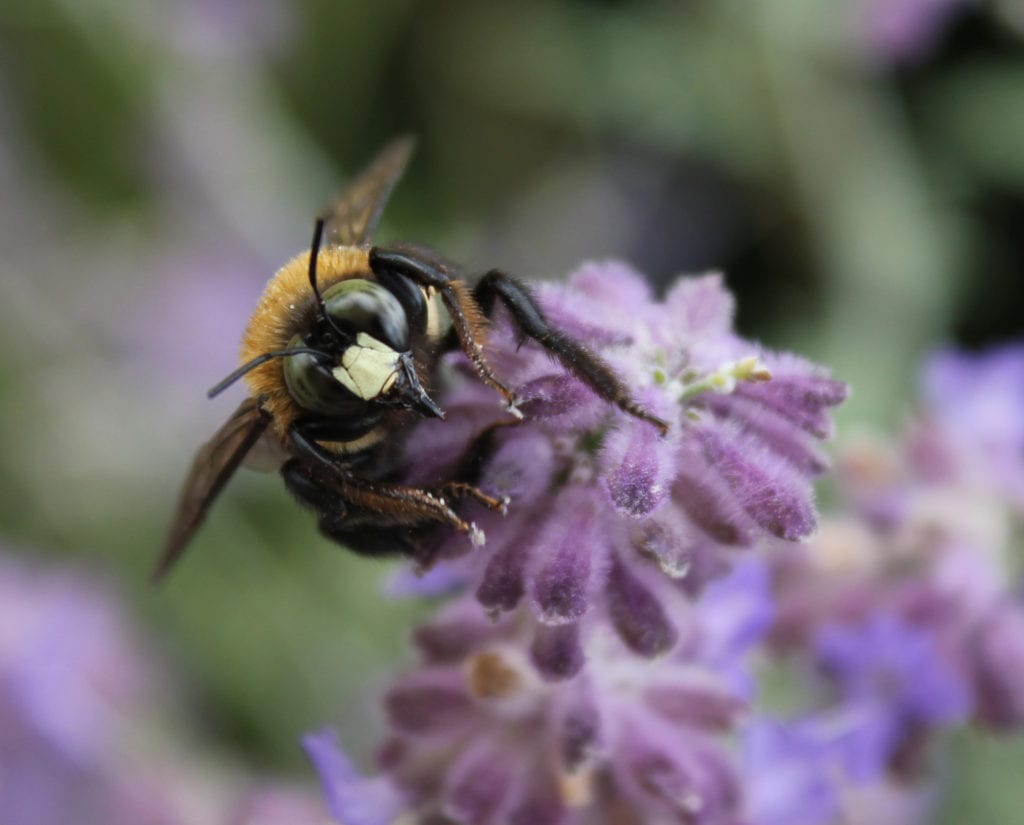
A male carpenter bee takes a moment to rest on Russian sage. Male carpenter bees have a white patch on their faces and are incapable of stinging.
Was this a bad bee doing pollinating good or simply a non-native bee competing with all the other bees? Was my garden host to other “bad bees”? I began to wonder who, exactly, was visiting my garden while I wasn’t paying attention. I decided to find out.
The Pollinators
When it came to the pollinators, I found the usual bees, the European honeybees (Apis mellifera) and the native bumblebees (Bombus species), both from the Apidae family of bees. Like honeybees, the native bumblebees are social, living in colonies. Also in this family, and previously unknown to me, was the eastern carpenter bee (Xylocopa virginica). Similar to bumblebees, only larger and with a hairless, shiny abdomen, they are important pollinators of open-faced flowers, such as phlox. These are solitary bees and create nests by tunneling in wood (hence the name) and are therefore often categorized as pests to be exterminated. Personally, I became rather fond of these large gentle bees that were completely unconcerned by my presence.
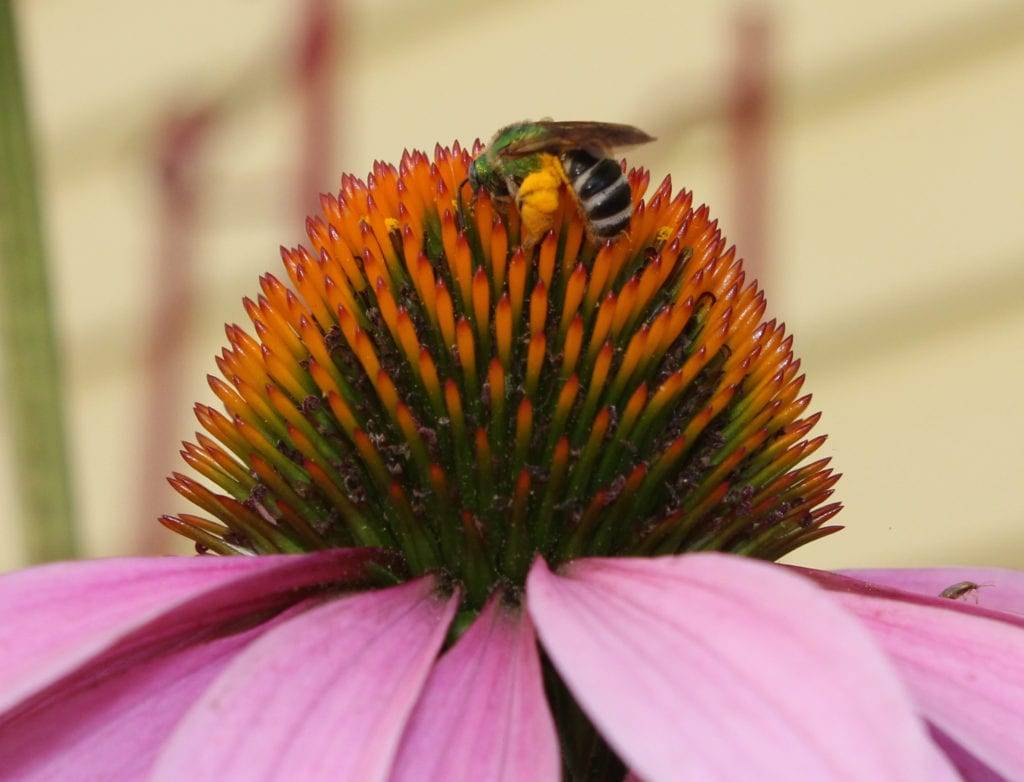
This green sweat bee is loaded up with pollen. Sweat bees seemed to have a preference for purple coneflower.
There were other bees more difficult to identify. Some, like the wool carder, were from the Megachilidae family, such as the mason and the leaf cutter bees. These native bees are solitary and create nests in narrow cavities. The mason bee uses mud to seal off the partitions in her nest, and the leaf-cutter uses cut leaves to line and seal her nest. And sure enough, I found their neat crescent cutouts on the leaves of my phlox and azalea.
Also in the Megachilidae family, and a frequent visitor in the early summer, was the giant resin bee (Megachile sculpturalis). This fairly large, long bee is native to Asia and lays eggs in existing cavities, such as carpenter bee tunnels, and, of course, uses resin and sap from trees to prepare the nest. It is not known how or whether these bees affect native bee populations.
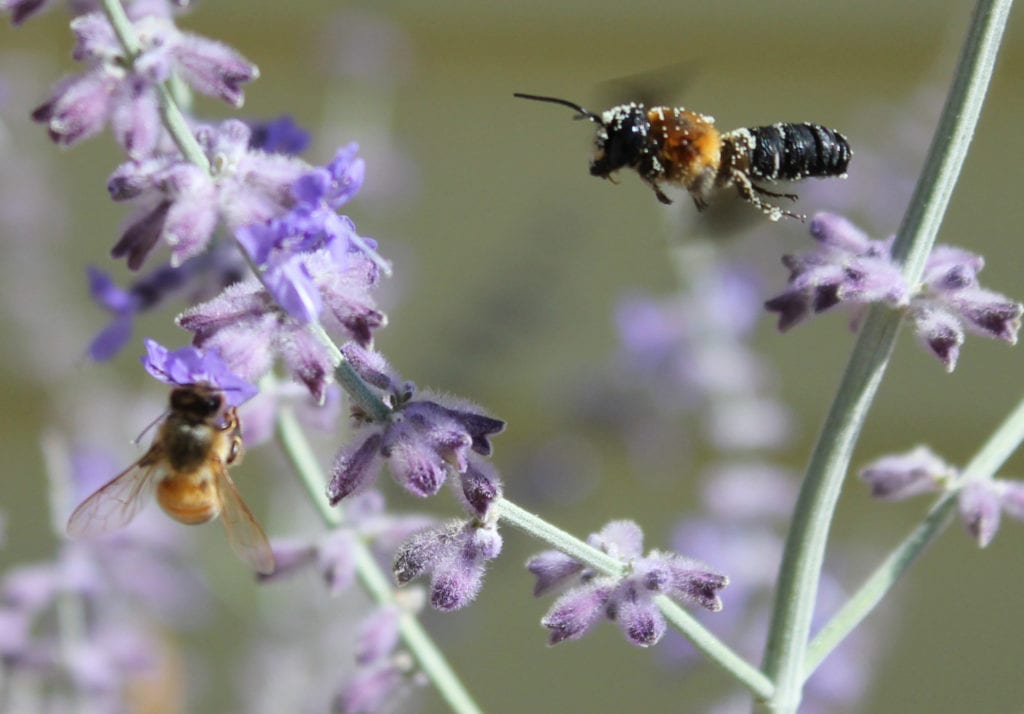
A giant resin bee covered with pollen joins a honeybee feeding on Russian sage.
The Megachilidae family of bees can be distinguished from other bees in that the pollen carrying hairs are under the abdomen rather than on the hind legs. These are considered to be very efficient pollinators and some species, such as introduced alfalfa leaf cutter (M. rotundata) and the native orchard mason bee (Osmia lignara), are used commercially for crop pollination.
Another regular throughout the summer was the sweat bee in the Halictidae family, including the more easily identifiable green sweat bee (Agapostemon virescens). Like many of the native bees, these are solitary and nest in bare soils. They are called sweat bees because they are attracted to human perspiration. Like Apidae bees, sweat bees collect pollen on their hind legs.
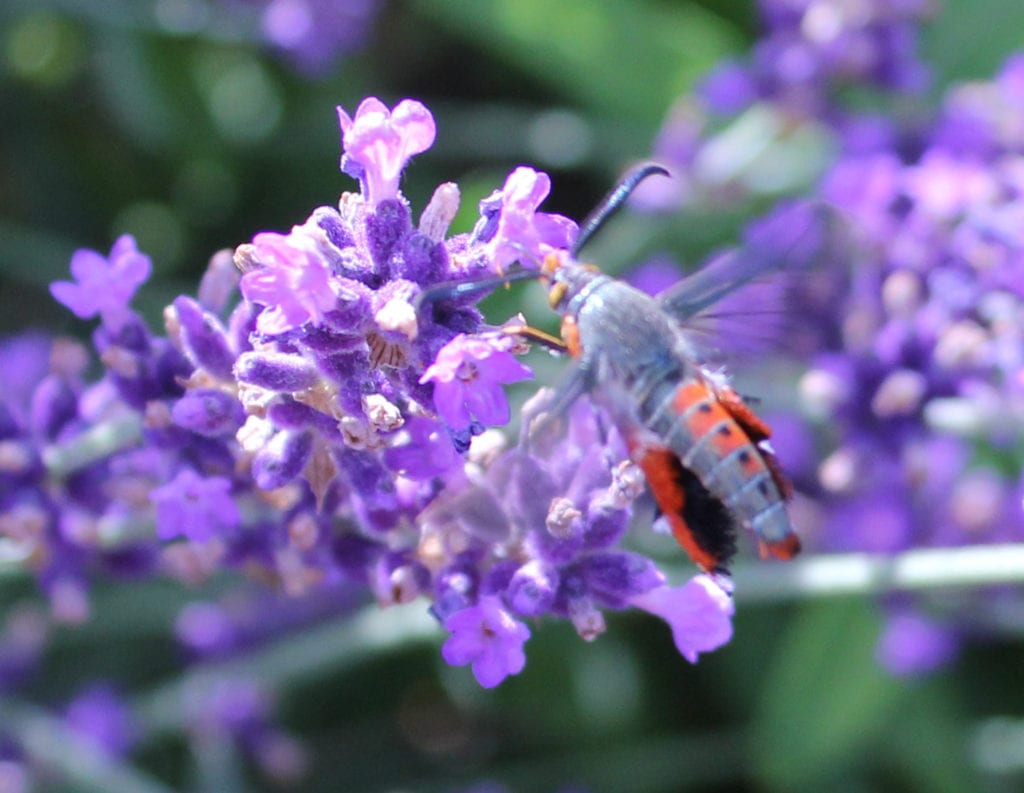
The squash vine borer is a garden pest, but is a pollinator as well.
Bees and butterflies of course are not the only pollinators. Various beetles, flies, wasps, borers, and moths also contribute. One of my early discoveries was a fancy red-suited insect foraging on lavender and catmint. This somewhat bizarre-looking insect turned out, to my dismay, to be the squash vine borer (Melitta curcurbitae), a moth native to North America. True to its name, my zucchini were dead by mid-August. Although not a desirable insect to have if you have squash in your vegetable garden, it is a pollinator.
In late August, I discovered another interesting, even more colorful moth, the Ailanthus webworm moth (Atteva aurea). In its native area of Central and South America, the larvae make webs on the native Paradise Tree, a tree in the Simarouba family. Further north, they eat and create webs in tree of heaven (Ailanthus altissima), also in the Simaroubaceae family. Tree of heaven, originally from China, is considered invasive. The spread of this insect north is thought to be due to the prevalence of Ailanthus. Considering the never-ending supply of tree of heaven sprouts in my gardens, I consider the presence of this insect to be good news.
As for butterflies, sadly, I saw none.
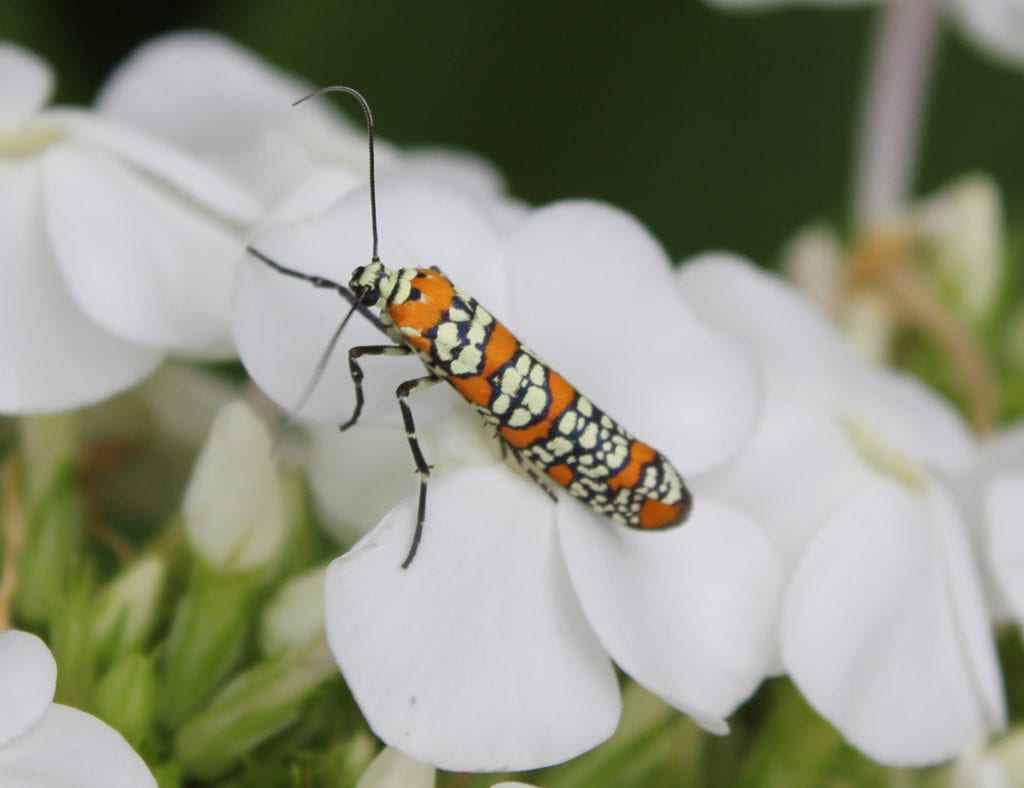
The larvae of the Ailanthus webworm moth, native to Central and South American, feed on and create webs in Ailanthus altissima.
The Non-Pollinators
The plant-insect relationship is complex and dependent on many insects besides pollinators. Non-pollinating insects tend to feed on other insects and on the saps and foliage of plants. Because many of them damage foliage and may contribute to plant decline, they are often considered pests and eradicated. However, in a balanced ecosystem, these species keep plant and insect populations in check. Like pollinators, they are also an important source of food for larger insects, birds, reptiles, and other creatures up the food chain. Although these insects have less marketing appeal than monarchs and bees, they are an essential part of the system.
Non-pollinators were not daily visitors like the bees, but appeared for short periods of time. Some I saw only once. Most, I likely never saw. One that I did happen upon was the Ichneum wasp (Therion morio), a parasite of moth caterpillars, including the fall webworm and tiger moth. The wasp injects eggs into caterpillars using its egg-laying organ, which looks like a stinger. As a parasite for webworms, it is considered beneficial.
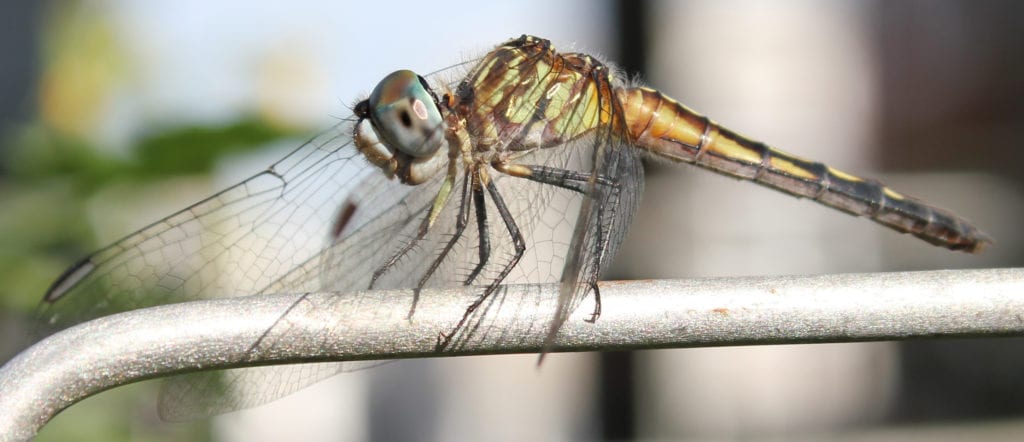
A blue dasher dragonfly perches on a garden trellis. Dragonflies and damselflies are ancient, agile aerial hunters that feed on small insects.
Toward the end of July, I saw two types of narrow-winged damselflies, the green fragile forktail and the familiar bluet, and a blue dasher dragonfly. Both damselflies and dragonflies are of the order Odonata and are aerial hunters, feeding on mosquitoes and small insects. They are typically found near water as they lay their eggs in water, yet the closest water body is a small brook about half a mile away. Apparently, adult dragonflies will travel a considerable distance from the water to feed. Perhaps, considering the variety of small insects in my garden, it is not surprising that I see these agile hunters.
In late summer, I glimpsed the brightly colored Candy Striped Leafhopper (Graphocephala coccinea) on my phlox and basil. A native species in the Cicadellidae family, this sleek, red and blue striped insect feeds on the juices of leaves and stems. They have piercing-sucking mouthparts that allow them to take in large amounts of fluid. They expel the excess from their rear ends making a tiny “pop” sound. If you watch closely, you can see the little bullets of fluid being shot out. Not surprisingly, these insects are commonly called sharpshooters.
Not only is butterfly milkweed (Asclepias tuberosa) an important source of nectar and pollen (common milkweed is preferred by monarchs for egg laying habitat), but it is a popular food source for non-pollinating insects as well. Every year a number of my plants are covered with orange Oleander aphids (Aphis nerii), non-native aphids from the Mediterranean. While not very good for the milkweed and certainly not appealing in the garden, aphids are a source of food for other insects, especially ladybugs.
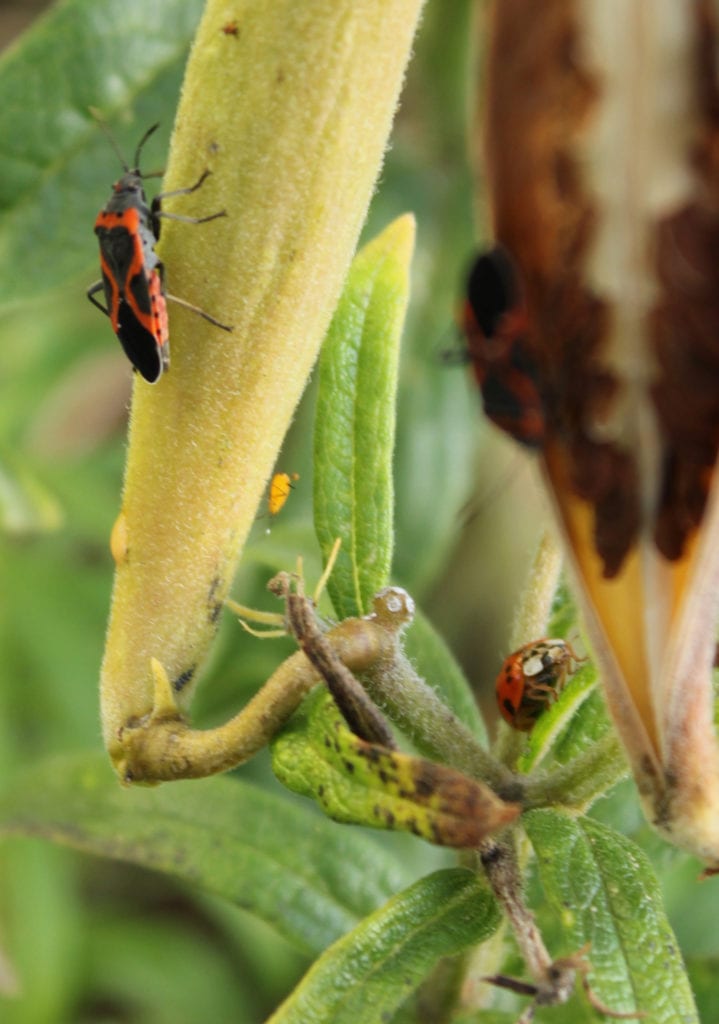
Milkweed bugs and aphids feeding on butterfly milkweed. In the back, a ladybug hunts for aphids.
In mid-August, it was hard not to miss the bright red and black of the small eastern milkweed bug (Lygaeus kalmii). A native species, these feed on the seeds of milkweed plants, and apparently, like the monarchs, no predators feed on them due to the toxins in the milkweed. Some people kill these, as well as the aphids, to protect their milkweed. As butterfly milkweed spreads prolifically in my garden, despite these pests, I leave both the aphids and the milkweed bugs be.
More than just a Pollinator Garden
By summer’s end, I felt as if I had opened a door into a world of miniature cutters, transporters, miners, borers, sapsuckers, predators, life-givers, and life-takers. From sunup to sundown, individually and collectively, they go about their work, feeding and creating nests, and in the process, constructing and deconstructing the earth around us. They need not only food, but also materials and places to build their nests, whether bare soil, wood, resin, or plant parts.
Nor is it only the insects in the visible, sunny realms of the garden that we need to be conscious of; all those unknown, nameless creepy crawlers living in compost bins, or in the deep darkness of the soil, need food (plant material) so they can do their work of decomposing, of turning matter back into soil to support the plants that support the insects that support both the plants and all the creatures up the food chain, including us.
Whether a patchwork of Pollinator Gardens and Monarch Waystations will be sufficient to support the populations of insects necessary to sustain natural systems and our crops, only time will tell. However, by accepting a little untidiness in our landscapes and by allowing plants to follow their natural life cycles of blooming, seeding, and eventually decaying, we provide a place on earth for insects to live and thrive.
About the Author
Tara Mitchell is a landscape architect with Massachusetts Department of Transportation. Her focus is on ecological restoration, naturalistic landscape design, native seeding, and vegetation management. Tara may be reached at tara.mitchell@state.ma.us.
***
Each author appearing herein retains original copyright. Right to reproduce or disseminate all material herein, including to Columbia University Library’s CAUSEWAY Project, is otherwise reserved by ELA. Please contact ELA for permission to reprint.
Mention of products is not intended to constitute endorsement. Opinions expressed in this newsletter article do not necessarily represent those of ELA’s directors, staff, or members.

